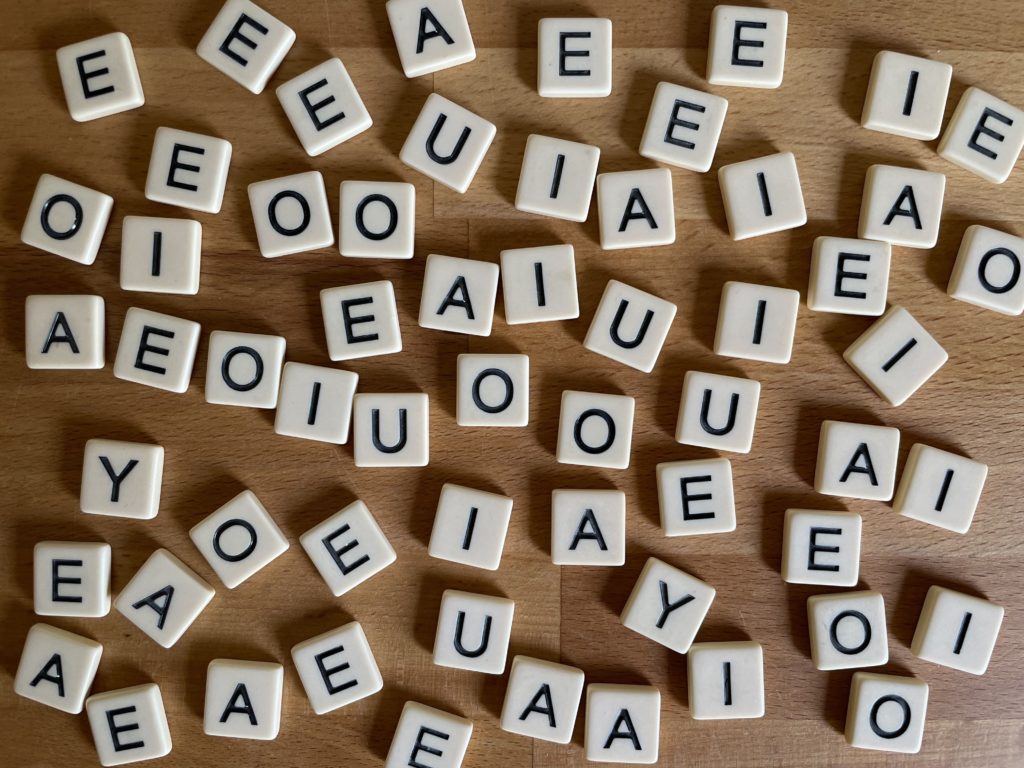Spanish vowels are the letters whose pronunciation forms the basis of the whole language.
When pronouncing a Spanish vowel, there is no obstacle to the outflow of air. This is in contrast to the Spanish consonants, whose pronunciation involves some obstruction to articulate their individual sounds.
With this in mind, familiarity with the vowels in Spanish is vital in order to understand the fundamentals of pronunciation and to work towards fluency in the language. So without further ado, let’s jump right in!
Spanish Vowels: The Basics
There are five vowels in Spanish: A, E, I, O, and U. They always match five vocalized sounds or phonemes: /a/, /e/, /i/, /o/, and /u/, so their pronunciation is quite simple, unlike in English. Syllables in Spanish are formed around the vowels, which we cover in more detail in this post on Spanish Syllabification.
Let’s look at some examples with each of the Spanish vowels. Try to pronounce every word out loud.
| Spanish Vowel | Word | English |
| A | – Avena
– Águila – Aviso |
– Oats
– Eagle – Warning |
| E | – Él
– Elefante – Entrenamiento |
– He
– Elephant – Training |
| I | – Idea
– Inicio – Iridiscente |
– Idea, thought
– Beginning – Iridescent |
| O | – Obstáculo
– Oído – Ornitorrinco |
– Obstacle
– Inner ear, hearing – Platypus |
| U | – Último
– Universo – Utópico |
– Last, final
– Universe – Perfect, ideal |
Spanish vowels are classified into two groups based on our mouth opening: open vowels and closed vowels.
Open vowels: A, E, O
Strong vowels, as they are also known, require opening the mouth wider, separating the tongue from the palate. There are three of them: A, E, and O. Notice the shape of your mouth as you pronounce each Spanish vowel:
- A: Arriba – Up
- E: Enfermedad – Disease
- O: Oscuridad – Darkness
Closed vowels: I, U
This group of vowels does not require a whole mouth opening to be pronounced. They just need a small space between the tongue and the palate. They are also known as weak vowels. There are only two closed vowels in Spanish: I and U.
- I: Inteligente – Intelligent
- U: Universidad – University
Y in Spanish: The special case
You are probably wondering about the letter Y in Spanish. This letter is unique in Spanish since it is the only one that may work both as a consonant using the phoneme /y/, and as a vowel using the phoneme /i/, creating diphthongs and triphthongs.
| Y phoneme | Word | English |
| /i/ | – Buey
– Hoy – Muy |
– Ox
– Today – Very |
| /y/ | – Ayudante
– Ensayo – Leyes |
– Assistant
– Essay – Laws |
When the Y has a consonant voicing, a linguistic phenomenon called “yeísmo” comes into play. Its explanation is quite simple: It consists of pronouncing the phoneme /y/ as the digraph LL. It is widely employed, both in Spain and in Latin America.
Spanish Vowels: Basic Pronunciation Rules
Spanish vowel pronunciation is undoubtedly much simpler compared with English. This is due to the fact that there are only five vowel sounds in Spanish! In English, on the other hand, the vowels can be pronounced with about 14 different sounds.
There are fundamental rules for the correct pronunciation of each vowel in Spanish. Let’s take a look at each of them.
Spanish vowels are always pronounced the same way
Here is the golden rule to avoid any pronunciation mistakes, helping you master each sound correctly and quickly. Spanish vowels will always sound the same whether they appear at the beginning, middle, or end of a word. This basic rule is a plus for an accurate, stylish, natural, and better pronunciation.
Let’s do an exercise: Read the following words aloud and focus on the corresponding vowel sound. There shouldn’t be any differences in the pronunciation of the highlighted vowel, regardless of its placement in the word.
| Spanish Vowel | Word | English |
| A | Asignatura | Subject |
| E | Extraterrestre | Alien |
| I | Incertidumbre | Uncertainty |
| O | Otoño | Autumn |
| U | Usualmente | Usually |
Spanish vowels are much shorter than English vowels
In Spanish, vowels sound shorter and choppier than in English. For example, the sound of the O in the word “sol” (sun) is very similar to the sound of the O in the word “poke” in English. Make sure you keep the Spanish vowel pronunciations short as you practice with each letter in the next section!
All vowels in a word must be pronounced
Spanish is considered a phonetic language which means that there are no silent vowels, and both vowels and consonants must all always be pronounced. (The only letter whose pronunciation is silent is the letter H, except when combined with the letter C to make the CH sound.)
Spanish Vowels: Pronunciation
In this section, we will focus on a brief description of each Spanish vowel sound, so pay close attention to the details:
A: This is the first open vowel. It is pronounced by placing your tongue away from the palate in a middle position inside the mouth. Your lips have to be wide open and stretched. The pronunciation sounds like the English word “ah”, but very quick. Try pronouncing the following words, focusing on the A sound:
- Amoroso – Loving
- Hermano – Brother
- Verano – Summer
E: The second open vowel is E. It is pronounced by bringing your tongue closer to the palate and placing it in the front of your mouth, and your lips must be a little open and stretched. The pronunciation sounds like the English word “eh” or in the word “may,” but very short. Try pronouncing the following words, with a focus on the E sound:
- Estéreo – Stereo
- Intermedio – Intermediate
- Metro – Subway
I: This is a closed or weak vowel. It is pronounced by placing your tongue at the front of the mouth, very close to the palate. Your lips, on the other hand, must be half-open and stretched. The pronunciation sounds like the English “ee” like in the word “tee,” but much shorter. Try pronouncing the following words, focusing on the I sound:
- Alivio – Relief
- Ciclo – Cycle
- Pensamiento – Thought
O: The final open vowel is O. It is pronounced by bringing the back of your tongue close to the palate. At the same time, the lips are slightly closed and well-rounded. For pronunciation, think of Santa Claus saying “ho-ho-ho”, but with the lips more pursed and rounded so the O sound is much shorter. Try pronouncing the following words, focus on the O sound:
- Cometa – Kite
- Dolor – Pain
- Oportuno – Convenient
U: This is the last of Spanish vowels. The U, being a closed vowel, is pronounced by bringing the back of your tongue very close to the soft palate, specifically at the back of your mouth. The lips, in turn, are very closed and rounded as well. The Spanish U is pronounced similarly to in the English word “tutu,” with an emphasis on keeping the lips tight and rounded. Try pronouncing the following words, focus on the U sound:
- Currículo – Curriculum
- Humo – Smoke
- Mutuo – Mutual
Spanish Vowel Combinations: Diphthongs
A diphthong is a letter combination where two Spanish vowels combine to form a single syllable. Diphthongs are generally organized into three groups:
Two closed vowels IU or UI: These diphthongs are known in Spanish as “diptongos homogénos.”
Closed vowel (I, U) + Open vowel (A, E, O): These diphthongs are known in Spanish as “diptongos crecientes” or “diptongos ascendentes.”
Open vowel (A, E, O) + Closed vowel (I, U): These diphthongs are known in Spanish as “diptongos decrecientes” or “diptongos descendentes.”
Here are the most common Spanish vowel combinations in each of the three diphthong groups. As you practice their pronunciation, remember that each diphthong forms a single syllable:
| Diptongo homogéneo | Word | English |
| /iu/ | – Diurno
– Oriundo – Viudo |
– Daytime
– Native – Widowed |
| /ui/ | – Buitre
– Cuidado – Juicio |
– Vulture
– Care – Judgment |
| Diptongo creciente | Word | English |
| /ia/ | Dialecto | Dialect |
| /ie/ | Tienda | Store |
| /io/ | Comercio | Trade |
| /ua/ | Paraguas | Umbrella |
| /ue/ | Cuerpo | Body |
| /uo/ | Ambiguo | Ambiguous |
| Diptongo decreciente | Word | English |
| /ai/ | Aire | Air |
| /au/ | Recaudo | Collection, Safekeeping |
| /ei/ | Veinte | Twenty |
| /eu/ | Neurona | Brain cell |
| /oi/ | Heroico | Heroic |
| /ou/ | Estadounidense | American |
Now that you have a good idea about these two-vowel combinations that form single syllables as diphthongs, we’ll just mention that there are sometimes even triple-vowel combinations known as triphthongs that have similar properties. If you’re keen on learning even more about these, we go into more detail on triphthongs in our post on Spanish syllables.
Conclusion
Well with that, you’ve gotten a good glimpse into the fantastic world of Spanish vowels. We covered the basics of which letters are considered vowels in Spanish, and how they’re considered either open vowels or closed vowels. We covered the fundamental pronunciation rules, along with the standardized pronunciation for each Spanish vowel. And finally, we introduced the single-syllable vowel combinations known as diphthongs.
With that, we encourage you to keep practicing proper pronunciation, with both Spanish consonants and vowels. Take advantage of online resources to get used to each sound, whether through music, dialogues, or even podcasts. And finally, be sure to practice speaking out loud in order to keep improving your pronunciation of the Spanish vowels!




